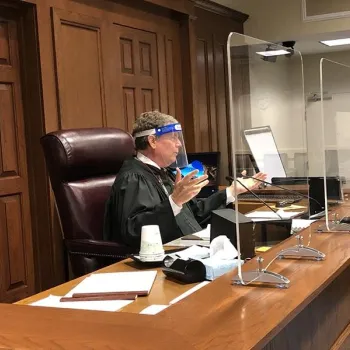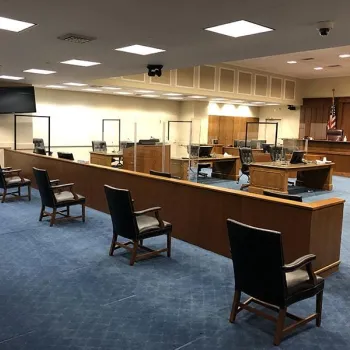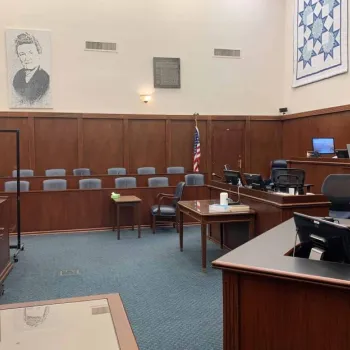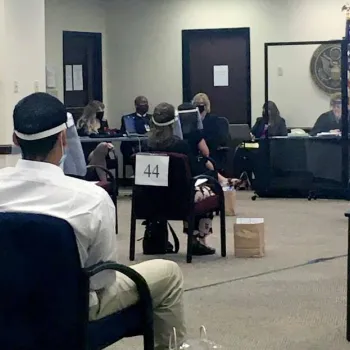The Judiciary is committed to innovative court management and administration that effectively addresses the changing needs of judges, court staff, the bar, and the public. Although the COVID-19 pandemic in 2020 tested court operations in unprecedented ways, the Judiciary kept that commitment.
Pandemic Response
Through a combination of careful planning, expanded use of technology, and the dedication of judges and thousands of employees, the federal Judiciary was able to keep the courts operating throughout the global COVID-19 crisis in 2020.
Courthouses around the country were forced to close their doors to the public during the worst days of the pandemic, but federal courts continued to fulfill their constitutional mission of administering justice by swiftly adopting new rules and protocols and implementing virtual technologies.
In February 2020, the Judiciary established its COVID-19 Task Force (Task Force) to coordinate the response to the pandemic. The Task Force assessed the impact of the virus on court operations nationally and provided advice on emerging issues. Its membership consisted of chief judges and court executives, federal defenders, staff of the Administrative Office of the U.S. Courts (AO), and representatives from the General Services Administration, the U.S. Marshals Service, the Federal Protective Service, and the U.S. Attorney’s Office.
Working with Congress, the Judicial Conference of the United States (the Conference) also successfully sought provisions in the Coronavirus Aid, Relief, and Economic Security Act (CARES Act) that authorized the use of videoconferencing and teleconferencing to conduct certain criminal proceedings for the duration of the crisis. In March, the Conference’s Executive Committee, acting on an expedited basis, approved a temporary exception to broadcast and camera prohibitions to allow judges to use teleconferencing technology to provide the public and the media with audio access to court proceedings during the pandemic.
The Judiciary greatly expanded its use of technology in other ways, increasing the courts’ bandwidth capacity, obtaining necessary equipment and licenses for new platforms, and strengthening its information technology (IT) infrastructure to address the greater use of telework.
Forced to close their courtrooms because of health and safety concerns, judges presided over proceedings remotely from home offices and kitchen tables. They adapted to multiple audio- and videoconferencing technologies to host oral arguments, initial appearances, preliminary hearings, arraignments, misdemeanor sentencings, and other proceedings.
Court employees worked remotely and posted orders and notices on their public websites about jury service, filing deadlines, and other court business, as well as information about public access to the courthouse, as local COVID-19 conditions changed.
Over the course of several months, the AO and the Task Force developed guidance on a wide range of pandemic-related issues in the areas of bankruptcy administration, budgets, court interpreting, court reporting, facilities and security, finance and internal control, financial disclosure, human resources and benefits, information technology, jury duty, naturalization ceremonies, probation and pretrial services, procurement, and telework.
In April, the AO published the Federal Judiciary COVID-19 Recovery Guidelines to provide courts with gating criteria to consider as they prepared for the phased return of courthouse operations. The criteria were based on recommendations from the Centers for Disease Control and Prevention and included the number of COVID-19 cases in a facility within a 14-day period, a sustained downward trend of cumulative daily COVID-19 case counts over a 14-day period in the community, and the rescission of local movement restrictions or shelter-in-place orders.
The guidelines emphasized local decision-making by the courts as they advanced through four phases on the way to returning to normal operations, similar to those that existed before the COVID-19 pandemic struck the United States. In the final weeks of 2020, with COVID-19 cases escalating around the country, about two-thirds of federal courts were in the first phase, which means that there was only minimal activity in courthouses, with health and safety protocols in place, and most employees were still working remotely. Only about a third had entered Phase Two or later phases, which allow for increasing levels of on-site proceedings in courthouses.
Grand jury proceedings and jury trials presented other unique challenges for the courts. The AO facilitated the work of a subgroup of the Task Force, which tackled the challenge of bringing jurors back into courthouses while keeping them and other participants safe.
In June, the subgroup, made up of trial judges, court executives, and representatives from the federal defender community and the Department of Justice, distributed to the courts a comprehensive report on conducting federal jury trials and convening grand juries during the pandemic. The report detailed a number of factors for courts to consider, from making changes to prospective juror questionnaires to creating safe spaces for jurors to deliberate.
The report offered suggestions about the type and amount of personal protective equipment needed to accommodate jurors, the public, attorneys, witnesses, and members of the press; juror travel to and from the courthouse; social-distancing and deep-cleaning procedures for courthouse spaces; and seating of jurors and other participants in ways that would mitigate health risks.
In the bankruptcy courts, judges entered orders and revised procedures on a wide variety of topics, including courthouse closures and clerk’s office operations, meetings of creditors, deadlines and time periods in pending cases, electronic signature requirements, and access to telephone and video technology for hearings.
The greater demands caused by the pandemic created an urgent need for additional funding, and the Judiciary made two separate requests to Congress for supplemental funding in 2020.
Pandemic Impact on First Step Act
Early release of inmates to the community under the First Step Act of 2018 was significantly affected by the pandemic. The Judiciary held discussions with Bureau of Prisons (BOP) officials on the expanded use of compassionate release and home confinement as COVID-19 spread among detainees in federal facilities. The Conference’s Criminal Law Committee approved a form to be used for motions filed by pro se inmates seeking compassionate release, along with an order template. The forms were distributed to the courts and BOP in June.
Pro se motions for compassionate release have increased significantly since the act was passed, and even more so during the pandemic. Standardizing the pro se motion form and court order helped courts make prompt and informed decisions, clearly conveyed the courts’ intent to BOP, and aided probation offices in investigating and establishing community release plans.
Audio Streaming Pilot
A two-year pilot program to evaluate audio streaming of oral arguments in district court civil cases of public interest was approved in March by the Conference. The live broadcasts will give the public access to real-time courtroom audio on the court’s website. Audio streaming of civil proceedings requires the parties’ consent and is subject to the presiding judge’s discretion. The pilot excludes trials or civil proceedings involving jurors; witnesses; or sealed, confidential, or classified materials.
The pilot will help identify livestreaming-related policy, technical, operational, budgetary, and administrative issues that the Conference’s Committee on Court Administration and Case Management can consider when evaluating potential amendments to the Judiciary’s broadcast policy. The committee recruited volunteer courts of varying size and from different regions to serve as pilot courts. By the end of November 2020, 13 courts had volunteered to participate. The pilot was expected to launch in early 2021.
Jury Instructions Related to Social Media
A new set of model jury instructions that federal judges may use to deter jurors from using social media to research or communicate about cases was sent to the courts in September. The model instructions caution jurors about the many ways social media can undermine a jury’s ability to deliver an impartial verdict. The instructions suggest that reminders about social media restrictions be given throughout the trial, instead of only at its beginning and end, as was also recommended in a 2012 version of the instructions.
The 2012 model jury instructions were drafted when fewer social media platforms existed, and when social media was less universally present in most jurors’ lives. Jurors today are more likely to see pop-up social media notifications on their phones and computers, making them more vulnerable to unintentionally hearing about a trial or a sensitive legal issue. And social media has been used with greater sophistication to communicate disinformation and influence public opinion. Taken together, these changes make it challenging for courts to ensure that jurors render their verdicts based only on the evidence in the case before them, as required by law.
Next Generation Case Management
A multi-year project to upgrade the Judiciary’s electronic case management system advanced in 2020 with additional courts brought online. It’s expected that by the end of 2021, all 94 federal district courts and the 13 courts of appeals will be up and running on the Next Generation (NextGen) Case Management/Electronic Case Files system, the Judiciary’s upgraded CM/ECF system.
As of Nov. 1, 2020, all appellate courts were on the NextGen system, and 51 district courts and 42 bankruptcy courts had been added. Approximately 97 percent of federal court units were either live or in the process of implementing the system in 2020. Implementation teams from the AO helped courts migrate and provided on-site assistance, mentoring, training workshops, go-live weekend support, and post-migration follow-up.
The upgrade allows Judiciary personnel and public users to provide a single login and password across courts and enables court staff to consolidate different views of case data into a single interface. For courts of appeals, the new system improves the attorney filer interface and allows judges and staff attorneys to download and store pending matters and supporting documents on mobile devices. District and bankruptcy judges and chambers staff can automatically gather materials relevant to pending motions or other matters.
Access to Interpreters
Spanish is the most frequently used language in interpreting proceedings in the courts, accounting for 97 percent of all reported interpreting events in fiscal year 2020. Federal courts used interpreters in 225,175 court proceedings in the 12 months ending Sept. 30, 2020. Overall, 122 different languages were used, and American Sign Language was used in 145 cases. The table below shows the top 10 languages that required interpreting.
| Language | Number of court proceedings |
|---|---|
| Spanish | 218,749 |
| Mandarin | 1,303 |
| Portuguese | 765 |
| Mixteco | 409 |
| Russian | 341 |
| Cantonese | 250 |
| Arabic | 245 |
| Romanian | 214 |
| Vietnamese | 192 |
| Punjabi | 159 |
Annual Report 2020
- Annual Report 2020
- Court Operations and Pandemic Response
- Funding/Budget
- The Courts and Congress
- The Federal Bench
- Accountability and Resource Management
- Facilities and Security
- Public Outreach
- Defender Services
- Probation and Pretrial Services
- Human Resources
- Information Systems and Cybersecurity
- Recent and Proposed Amendments to Federal Rules
- In Profile




